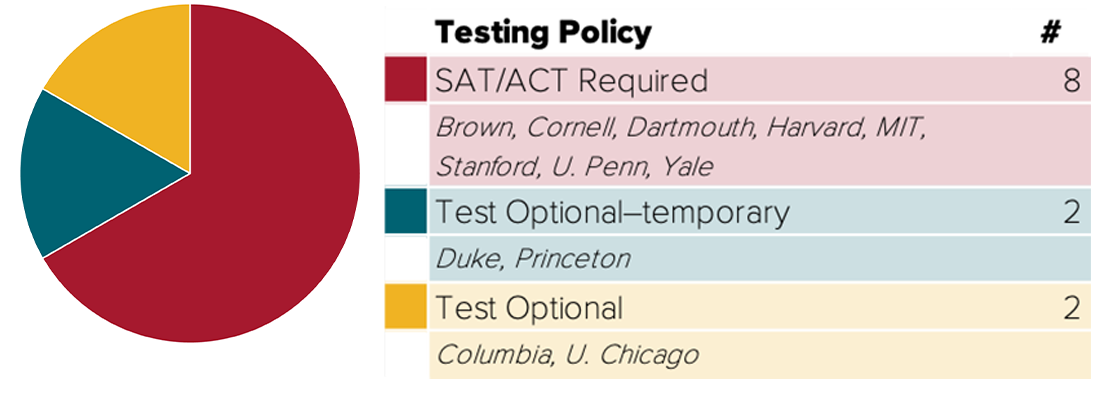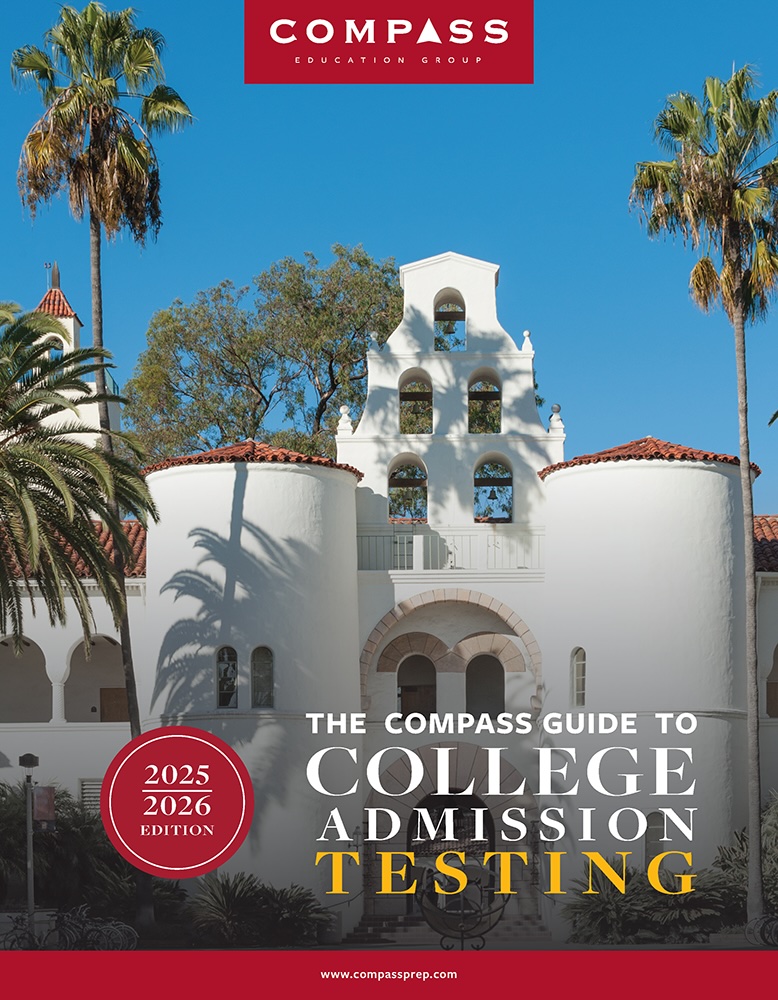
The momentum to reinstate standardized testing requirements has only accelerated this year, with an expanding roster of prominent institutions signaling a fresh emphasis on test scores. The growing list of popular colleges and universities that require testing for some or all undergraduate programs includes:
Harvard University
Stanford University
MIT
Yale University
University of Pennsylvania
Caltech
Johns Hopkins University
Brown University
Cornell University
Dartmouth College
Carnegie Mellon University
The Cooper Union
Georgetown University
University of Texas–Austin
Georgia Tech
Ohio State University
Purdue University
University of Florida
University of Georgia
University of Miami
University of Tennessee
Florida State University
Service Academies (all)
Many other schools have also refined their positions, with some stating a preference or recommendation for applicants to submit test scores, even when not strictly required. As the pandemic-era flexibility around testing is receding, the conversation around the role of standardized tests in admissions is becoming more nuanced than ever. Meanwhile, college counselors and college admissions insiders are keenly monitoring the expiring policies of several notable schools that remain temporarily test optional and whose position in the marketplace could influence test-taking behavior.
OPTING TO TEST HAS ADVANTAGES
More and more students continue to obtain scores. Following consecutive substantial year-over-year increases in SAT takers in previous classes, participation reached 90% of pre-pandemic numbers this cycle. The streamlined digital SAT that debuted in 2024 has been relatively well-embraced by students and the launch of the leaner ACT this year is also drawing ample attention.
Submission rates are ticking up as well. With some of the more sought-after colleges requiring testing, students with stronger scores are inclined to also submit scores to test optional colleges. Applicants who test benefit from the flexibility to decide how their results should or should not factor into their final strategy.
Although it can’t be said that sending scores will automatically lead to better outcomes, recent statistics from a sampling of competitive colleges imply a greater likelihood of admission for applicants with test scores than for those without, in some cases more than twice as high. Top scores are also associated with better GPAs and other measures of success, so this apparent “testing advantage” is often misunderstood, misinterpreted, and over-emphasized. Submitting scores, though, remains a means for students to distinguish themselves from other applicants.
Colleges are hesitant to report admission statistics by test submission status, but there is some available evidence. Below is a snapshot from a sampling of well-known institutions** that have released figures in announcements or reports since the pandemic. While inexhaustive, these outcomes offer a glimpse into the additive role test scores and submission decisions played in more competitive contexts.

** BU, Georgetown, Georgia Tech, UPenn, USC, UVA, Amherst, BC, Colgate, Emory, Cornell, Notre Dame, Tufts
Students planning to apply to highly popular colleges should consider what others with similar opportunities are apt to submit as a competitive edge. Scores remain a valuable piece of the holistic review process at many schools, especially those where demand for admission drastically outstrips supply.
TEST OPTIONAL IS HERE TO STAY
The consensus is that more colleges will reinstate testing, especially highly competitive ones. However, it’s also believed that hundreds of other colleges will remain test optional forever. The chart below consolidates well-known colleges into major policy categories. Within the groupings of test optional institutions, applicants may encounter cues and evolving policies communicated by individual colleges. Without demanding test scores outright from all applicants, some institutions (or majors) will indicate that submitting test scores is encouraged or even expected in the absence of special circumstances. It is important for prospective applicants to pay close attention to a college’s guidance and admission tendencies.
Current testing policy breakdown for the 400+ schools Compass tracks:

Current testing policy breakdown for the 12 “Ivy Plus” schools:

PARSING TEST OPTIONAL POLICIES
The test optional landscape is a fragmented field, with colleges on a spectrum regarding what is or isn’t preferred or recommended. It is risky to interpret or present test policies in binary terms (required vs. optional). In actuality, there is a range of institutional philosophies and complicated relationships with testing. It is best to examine colleges case-by-case to understand what is expected. Moreover, testing’s relevance and evaluation often differ between pools of applicants to the same college in the same year, and yet colleges try to address all applicants with uniform policy language. This is as frustrating for colleges as it is confusing for applicants.
TO SUBMIT OR NOT
Unfortunately, test optional ubiquity has introduced an unintended strategic element to the process. Some students have successfully gamed it, while others have made tactical errors of “mis-withholding” scores that would have helped.
It is an easy miscalculation to make. The new normal of discretionary testing has inflated the averages of reported scores and caused unhelpful distortions to published figures. This statistical deception leads to dubious implications and bad decisions by both applicants and readers. Students might fear a score is now “too low” to disclose, while admissions officers might assume the applicant is concealing a score that is lower than it truly is. That leaves counselors feeling understandably irresolute about advising students.
Will a reader assume nothing about the absence of a score when their college’s own research confirms that withheld scores are typically 100–150 points below their average?
Admissions Research Consortium Study: SAT scores and academic performance at 47 public and private universities (* Percentiles were calculated within an institution’s student population.)

Slowly, the prevailing best practice seems to be moving toward sending scores, when in doubt. In fact, this strategy might be most fitting at schools with exceedingly low acceptance rates. At such outliers, readers already know the bulk of applicants will be denied, so they search for reasons to admit. Paradoxically, while even a near-perfect SAT score won’t stand out as reason alone to admit someone, a score slightly below a college’s middle range will typically still be seen as affirming and “high enough” if the rest of the application wholly supports that decision. On the other hand, colleges that are a bit less selective but conspicuously aspirational may be more intent on protecting their averages.
It is therefore impossible to give a rule that applies to all students in all situations. So instead, we encourage you to seek your college counselor’s advice and appraise the wording of specific policies for additional insight into a school’s attitude toward testing. Statements released by a number of popular schools include color about where they stand and what they are experiencing. For instance:
- The decision to suspend our testing requirement was in response to the pandemic; our suspension is—for now—temporary;
- Those who have ACT/SAT scores are welcome/encouraged to submit them;
- Those who have test scores from other standardized exams may submit those;
- Test scores are considered in context. Even if your score is not above average for [the college], but it is for your high school or neighborhood, your score may help you in the admission process;
- Under a test-optional policy, those who provide test scores fared better in the application review process.
It can then be helpful to place any given college into one of three frameworks:
- WHERE TESTING IS IMPORTANT
These colleges have admit rates around or below 10%. Almost every applicant is qualified; virtually every applicant is denied. Test optional policies have lowered admission rates further. Applicants must provide a strong case for admission. Students can choose to demonstrate a strength in testing or choose to blend in with other non-submitters. As the data on the previous page show, finding a way to stand out can still provide an advantage.
- WHERE TESTING CAN ADD VALUE
Supply and demand imbalances necessitate a difficult and careful selection process, but applications are read supportively. Test scores have traditionally mattered but not more than a sustained track record of academic achievement. Strong test scores can help but are not a significant difference maker.
- WHERE TESTING IS A LOWER PRIORITY
This is true at colleges that accept the majority of their applicants and evaluate applications based largely on a yes/no assessment of whether a student has shown the capability to succeed at their institution. Admission decisions don’t hinge on test scores, and it appears that testing will only further diminish in importance at such schools moving forward.
At Compass, we look forward to discussing your specific testing considerations. When you’re ready to reach out, we’re here to guide you on the road ahead.

